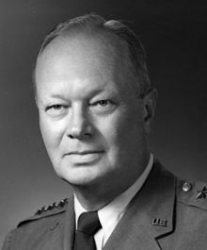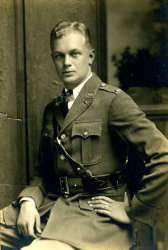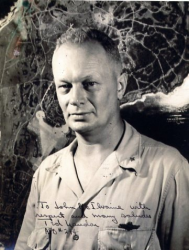Truman Hempel Landon
General, U.S. Air Force
World War II
Truman Hempel Landon was born on 11 February 1905 in Maryville, MO, the son of Perry Oliver and Helen Hempel Landon. He grew up in Carlinville, IL, and graduated from Carlinville High School in 1922. He attended Blackburn College, a private liberal arts school in Carlinville, before entering the U.S. Military Academy in 1924. Upon graduating with the class of 1928, he was commissioned a Second Lieutenant in the U.S. Army Air Corps.
Landon began flight training at the Air Corps Primary Flying School at Brooks Field, TX. From there he entered training at the Air Corps Advanced Flying School at Kelly Field, TX, and graduated on 15 February 1930. After receiving his pilot's rating, his first assignment was with the 3rd Attack Group at Fort Crockett, TX. From 1932-36, he was a flying instructor at the newly-dedicated Randolph Field (near San Antonio, TX), which replaced the Air Corps Primary Flying School at Brooks Field. In 1937, Landon was transferred to France Field in the Panama Canal Zone, where he served as a flying instructor with the Sixth Bomb Group.
Flight into History at Pearl Harbor
In 1939, Landon became commander of the 38th Reconnaissance Squadron (Heavy) at Hamilton Field, CA. In that role, on 13 May 1941, he participated in the first mass flight of B-17s from Hamilton Field, CA, to Hickam Field, HI. On 6 December 1941, in response to the growing crisis in the Pacific, Major Landon's squadron departed Hamilton Field with four B-17Cs and two new B-17Es that were to be delivered to Clark Field in the Philippines to reinforce the American Far East Air Force there. They were scheduled to refuel at Hickam Field. His planes departed at 2-minute intervals beginning around 8:00 PM Saturday night. To conserve fuel for the long 14-hour flight to Hawaii, the planes were at staggered altitudes and all unnecessary items were stripped from the aircraft. So although the B-17s had the normal compliment of big machineguns, they carried no ammunition - planning to pick it up in Oahu.
Ahead of Landon was the B-17 piloted by Captain R.T. Swenson and it was now rounding Diamond Head and preparing to land at Hickam. Gazing across the large Hawaiian coast line from his own high-altitude perspective, Major Landon noticed a group of nine planes flying north. At first he thought it was a reception committee to greet his B-17s and escort them to Hickam Field. His pleasant thoughts were shattered by a sudden burst of machinegun fire as the nine planes flashed past him on the way back to their aircraft carrier; their red circles of the Empire of Japan glowing in the morning sun. Landon quickly pulled up into the clouds to escape pursuit.
In Captain Swenson's B-17, the crew noticed that Henderson Field was shrouded in smoke but thought the locals were burning sugarcane; all were totally unaware of the battle taking place below them! The landing gear was lowered and the B-17 had dropped to 600 feet for final approach before the crew got a good look at the airfield, now fully under attack. Japanese Zeroes zoomed in to rake their B-17 with a stream of tracers. It was too late to pull up and abort, so Swenson steeled himself against the impending inferno and stayed on course. In the rear of the bomber, Flight Surgeon 1st Lieutenant William Schick cried out, "Damn it! Those are real bullets they're shooting. I'm hit in the leg." Smoke filled the cockpit as the B-17 dropped earthward then hit hard on what was left of the runway - breaking the big bomber completely in half. In that moment Captain Swenson's B-17 gained the dubious distinction of being the first American airplane to be shot down in World War II; and Lieutenant Schick became the first American airman killed in the air in an American airplane.
In the clouds above Oahu, Landon had few options left. His B-17 was low on fuel and there was no place to run. On the radio he requested landing information from the tower below. Almost calmly the voice at the other end provided wind direction, velocity, direction of approach and the runway on which to land. "Be advised," the radio operator continued, "we are under attack by unidentified air planes." Having no other options, Landon nosed forward towards the smoke and the rain of fire below him, while enemy dive bombers and torpedo planes continued to flash across the skies. Years later, actor Norman Alden would portray Landon in that moment of horror in the movie Tora! Tora! Tora! The movie's version of events may well have captured Major Landon's true thoughts as he headed earthward in an attempt to save his plane and crew. He was awarded the Silver Star Medal for his actions on 7 December 1941 and the citation reads (in part):
"Major Landon, Echelon Commander on a flight from Hamilton Field, California, after an all-night flight and with only a small quantity of gasoline remaining which necessitated an early landing, arrived in the vicinity of Hickam Field during the Japanese attack and was subjected to heavy anti-aircraft fire and was attacked by Japanese aircraft. Major Landon's flight was unarmed and unprepared for an attack and rather than risk damaging the aircraft under his control by landing in an inadequate, although protected field, brought about the safe landing of his flight through his skill, coolness and daring under fire."
After the declaration of war, in 1942 Landon served as Assistant Chief of Staff, Seventh Air Force, at Hickam Field, then he went to Fort George Wright, WA, as Assistant Chief of Staff for Operations and Training (A-3), Second Air Force. In 1943, he was first Commanding Officer, and then Commanding General, of the Seventh Bomber Command. During this time the Seventh operated from Hickam Field; Funafuti Atoll; Tarawa Atoll; Kwajalein Atoll; and the Island of Saipan. In 1944, Landon had temporary duty as Commander of Task Group 57.2 in the Gilbert and Marshall Islands, Central Pacific Campaign, under Admiral Chester W. Nimitz.
During 1944-48, Landon had the following assignments in Washington, DC: Student at the Army and Navy Staff College; Senior Air Instructor, Army and Navy Staff College; and Deputy Commandant of the National War College. Still in Washington during 1949-50, he was Air Force member of the Joint Strategic Survey Commission, Office of the Joint Chiefs of Staff. He participated in drafting National Security Council Report 68 (NSC-68), a 58-page classified report issued by the NSC on 14 April 1950, during the presidency of Harry S. Truman. Written during the formative stage of the Cold War, it was top secret until it was declassified in 1975 and made public. As one of the most significant statements of American policy in the Cold War, it largely shaped U.S. foreign policy for the next 20 years. The strategy outlined in NSC-68 achieved ultimate victory, according to this view, with the collapse of the Soviet power and the emergence of a "new world order" centered on American liberal-capitalist values. Truman officially signed NSC-68 on 30 September 1950.
In 1950-51, Landon had the following assignments at Headquarters U.S. Air Force in Washington: Assistant to the Deputy Chief of Staff for Operations; Director of Plans and Operations, Office of the Deputy Chief of Staff for Operations; and Director of Plans, Office of the Deputy Chief of Staff for Operations. He finally got to leave Washington from 1951-53 when he served as Deputy Commander-in-Chief and Chief of Staff of the U.S. Air Forces in Europe, based in Wiesbaden, Germany.
Landon returned to Washington in 1953 and served in these two assignments at Headquarters U.S. Air Force: Assistant Deputy Chief of Staff for Operations; and Inspector General. In 1956, he was appointed Commander of the Caribbean Air Command at Albrook AFB in the Panama Canal Zone.
His last assignment at Headquarters U.S. Air Force, in Washington, was as Deputy Chief of Staff for Personnel from 1959-61.
Landon was awarded the four-star rank of General on 28 June 1961, before he returned to Germany for his final two assignments in the Air Force during 1961-63. First, he served as Commander-in-Chief of the U.S. Air Forces in Europe at Wiesbaden, and then as Commander of the Fourth Allied Tactical Air Force at Ramstein AFB.
He retired from active duty on 1 July 1963.
Medals and Awards
General Landon was rated a Command Pilot with over 7,800 hours of flight time. His medals and awards included:
Distinguished Service Medal
Silver Star Medal
Legion of Merit
Distinguished Flying Cross with Oak Leaf Cluster
Air Medal with two Oak Leaf Clusters
Army of Occupation Medal
American Defense Service Medal
American Campaign Medal
Asiatic Pacific Campaign Medal
National Defense Service Medal
World War II Victory Medal
Honors
General Landon was the recipient of an honorary Doctor of Laws degree conferred by Long Island University, on 29 January 1960.
Personal
In the category of personal interests, Landon was an avid golfer that shot in the seventies. He was very interested in foreign affairs and spoke fluent German and Spanish, which he used to make a number of speeches in those countries.
Death and Burial
General Truman Hempel Landon died on 27 January 1986, at the age of 80. He is buried at the United States Air Force Academy Cemetery in Colorado Springs, CO, in Plot 003 B 080.
He was survived by his second wife, Willda V. Landon, who died on 11 October 2000. His first marriage was to Louise Timberlake Priest in January 1930, in Tennessee.










